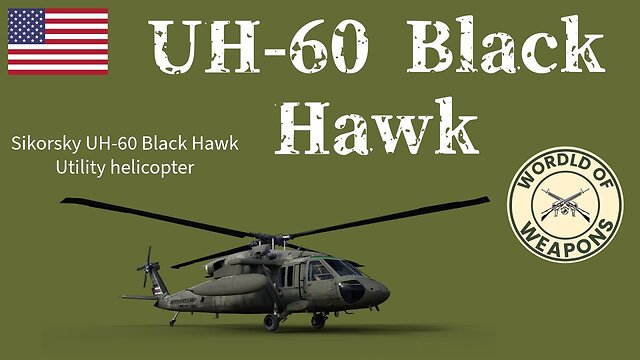Premium Only Content

UH-60 Black Hawk 🇺🇸 The Backbone of Modern Air Assault
1.Introduction 00:00
2.Development 01:36
3.Design 03:30
Introduction:
The Sikorsky UH-60 Black Hawk is a four-blade, twin-engine, medium-lift utility military helicopter manufactured by Sikorsky Aircraft. Sikorsky submitted the S-70 design for the United States Army's Utility Tactical Transport Aircraft System (UTTAS) competition in 1972. The Army designated the prototype as the YUH-60A and selected the Black Hawk as the winner of the program in 1976, after a fly-off competition with the Boeing Vertol YUH-61.
Named after the Native American war leader Black Hawk, the UH-60A entered service with the U.S. Army in 1979, to replace the Bell UH-1 Iroquois as the Army's tactical transport helicopter. This was followed by the fielding of electronic warfare and special operations variants of the Black Hawk. Improved UH-60L and UH-60M utility variants have also been developed. Modified versions have also been developed for the U.S. Navy, Air Force, and Coast Guard. In addition to U.S. Army use, the UH-60 family has been exported to several nations. Black Hawks have served in combat during conflicts in Grenada, Panama, Iraq, Somalia, Ukraine, the Balkans, Afghanistan, and other areas in the Middle East.
Development:
In the late 1960s, the United States Army began forming requirements for a helicopter to replace the UH-1 Iroquois, and designated the program as the Utility Tactical Transport Aircraft System (U T T A S). The Army also initiated the development of a new, common turbine engine for its helicopters that would become the General Electric T700. Based on experience in Vietnam, the Army required significant performance, survivability and reliability improvements from both UTTAS and the new powerplant. The Army released its UTTAS request for proposals (RFP) in January 1972. The RFP also included air transport requirements. Transport within the C-130 limited the UTTAS cabin height and length.
The UTTAS requirements for improved reliability, survivability and lower life-cycle costs resulted in features such as dual-engines with improved hot and high altitude performance, and a modular design (reduced maintenance footprint); run-dry gearboxes; ballistically tolerant, redundant subsystems (hydraulic, electrical and flight controls); crashworthy crew (armored) and troop seats; dual-stage oleo main landing gear; ballistically tolerant, crashworthy main structure; quieter, more robust main and tail rotor systems; and a ballistically tolerant, crashworthy fuel system.
The Army selected the UH-60 for production in December 1976. Deliveries of the UH-60A to the Army began in October 1978 and the helicopter entered service in June 1979.
Design:
The UH-60 features four-blade main and tail rotors, and is powered by two General Electric T700 turboshaft engines. The main rotor is fully articulated and has elastomeric bearings in the rotor head. The tail rotor is canted and features a rigid crossbeam. The helicopter can carry 11 troops with equipment, lift 2,600 pounds (1,200 kg) of cargo internally or 9,000 pounds (4,100 kg) of cargo (for UH-60L/M) externally by sling.
The Black Hawk helicopter series can perform a wide array of missions, including the tactical transport of troops, electronic warfare, and aeromedical evacuation. In air assault operations, it can move a squad of 11 combat troops or reposition a 105 mm M119 howitzer with 30 rounds ammunition and a four-man crew in a single lift. The Black Hawk is equipped with advanced avionics and electronics for increased survivability and capability, such as the Global Positioning System.
The UH-60 can be equipped with stub wings at the top of the fuselage to carry fuel tanks or various armaments.
The unit cost of the H-60 models varies due to differences in specifications, equipment and quantities. For example, the unit cost of the Army's UH-60L Black Hawk is $5.9 million while the unit cost of the Air Force HH-60G Pave Hawk is $10.2 million.
-
 3:20
3:20
World Of Weapons
1 year agoChiappa Rhino 🇮🇹 Italian strength, power and softness at the same time
114 -
 LIVE
LIVE
The Bubba Army
20 hours agoMinneapolis Shooter Story Unfolds! - Bubba the Love Sponge® Show | 8/28/25
9,236 watching -
 26:00
26:00
DeVory Darkins
1 day ago $8.08 earnedDemocrat Mayor HUMILIATES himself during painful interview as Trump makes SHOCKING Announcement
11K65 -
 22:14
22:14
Ohio State Football and Recruiting at Buckeye Huddle
1 day agoOhio State Football: Everything Steve Sarkisian Said About the Buckeyes This Week
72 -
 28:59
28:59
The Jack Brewer Show
12 hours agoThe Jack Brewer Show S1 EP5 Charles Duke Tanner on Redemption, Fatherhood & Second Chances #podcast
16 -
 15:33
15:33
Bearing
22 hours agoSEPTUM RING THEORY 💥 Are Nose Ring Girls ALL INSANE LIBERALS?! 💀🤣
2.92K53 -
 1:18
1:18
WildCreatures
2 days ago $0.63 earnedTourists unintentionally come face to face with jaguar in Brazil's Pantanal
1.4K14 -
 40:36
40:36
State of the Second Podcast
17 hours agoWhy Training Is an Investment in Your Life (ft. Tre’Von Barber)
41 -
 10:32
10:32
Nikko Ortiz
15 hours agoFunniest Fails Of The Month
24.6K3 -
 1:03:43
1:03:43
Dialogue works
1 day ago $0.40 earnedCol. Larry Wilkerson: Warning Signs Everywhere: U.S. on the Verge of Disaster
16.1K9